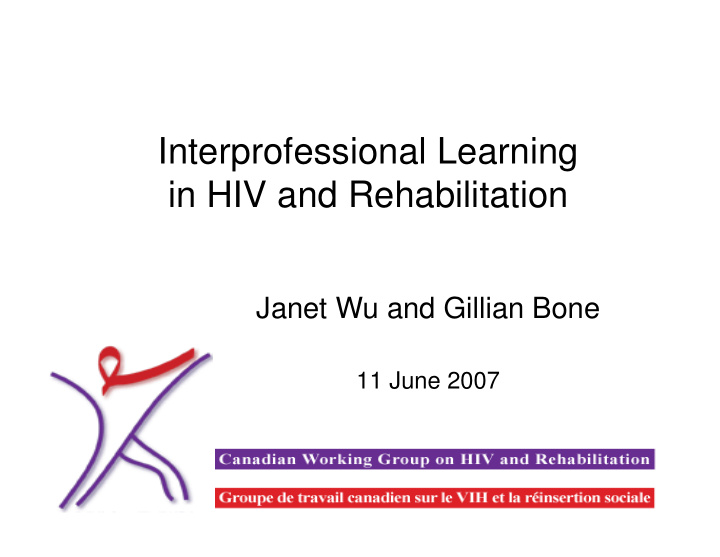



Interprofessional Learning in HIV and Rehabilitation Janet Wu and Gillian Bone 11 June 2007
Learning Objectives • To present an innovative national capacity building project • To describe an interprofessional education model for rehabilitation professionals Canadian Working Group on HIV and Rehabilitation
Outline • Introduction to CWGHR • Context of HIV and Rehabilitation • Interprofessional Learning Project • Opportunities and applicability Canadian Working Group on HIV and Rehabilitation
CWGHR Canadian Working Group on HIV and Rehabilitation National, multi-sector, non-governmental Addresses rehabilitation issues in the context of HIV Centred on the needs of people living with HIV Canadian Working Group on HIV and Rehabilitation
Adults and Children Estimated to be Living with HIV in 2006 www.unaids.org
The Need BC Prevalence Study Impairments, activity limitations and participation restrictions: Prevalence and associations among persons living with HIV/AIDS in British Columbia. Rusch, Nixon, Schilder, Braitstein, Chan & Hogg. Health and Quality of Life Outcomes, 2004, 2:46 http://www.hqlo.com/content/2/1/46 Canadian Working Group on HIV and Rehabilitation
Conclusions Demonstrated remarkably high prevalence of disablement among persons living with HIV in British Columbia � At least 80% experienced at least one impairment, activity limitation or participation restriction in the past month. � High prevalence of mental health issues Demonstrated need for rehabilitation among persons living with HIV Canadian Working Group on HIV and Rehabilitation
Rehabilitation Response Canadian Providers Survey Rehabilitation in HIV/AIDS: Development of an Expanded Conceptual Framework. Worthington, Myers, O'Brien, Nixon & Cockerill. AIDS Patient Care and STDs , 2005, 19:4, 258-271. HIV & Rehabilitation. The Canadian Providers’ Survey. In progress. Worthington, Myers, Cockerill, Nixon, O’Brien, Bereket. HIV Social, Behavioural and Epidemiological Studies Unit, University of Toronto. Survey Fact Sheets www.hivandrehab.ca Canadian Working Group on HIV and Rehabilitation
Results 61% rehabilitation professionals had never knowingly served an HIV positive client Of the 39% of rehab professionals who had served an HIV positive client: • average 4 clients in past year • 75% stated that < 25% of issues were HIV related 27% had received training in HIV/AIDS 91% strongly agreed/agreed that specialized training is needed Canadian Working Group on HIV and Rehabilitation
Role for Rehabilitation • People are living longer lives with HIV • Multi-systemic disease affecting neurological, cardiorespiratory and musculoskeletal systems • Unpredictable cycles of wellness and illness • Increasing prevalence of impairments, activity limitations and participation restrictions Canadian Working Group on HIV and Rehabilitation
Innovative Initiative Interprofessional Learning in Rehabilitation in the Context of HIV: Stakeholder Capacity Building Through Development of New Knowledge, Curriculum Resources and Partnerships Canadian Working Group on HIV and Rehabilitation
Project Purpose To increase the capacity of rehabilitation professionals to respond to the rehabilitation needs of people living with HIV/AIDS in Canada Canadian Working Group on HIV and Rehabilitation
Project Objectives 1. To develop new and enhance existing knowledge-based relationships 2. To increase awareness of existing and new curriculum resources, educational initiatives, programs & tools 3. To increase knowledge & skills related to HIV among rehab professionals Canadian Working Group on HIV and Rehabilitation
Process • Established national advisory committee • Integrated evaluation plan • Developed partnerships National rehabilitation organizations National HIV organizations Academic Sites and Community Members • Conducted a literature review and environmental scan Canadian Working Group on HIV and Rehabilitation
Model of Intersecting Components of Curricula in the Phase I Compendium Section D: Section B: HIV Curriculum for Health Care HIV Curriculum Specific Professionals (may or may not to Rehabilitation include rehab professionals) Professionals (no IPE) HIV/AIDS Curricula Curricula Not Other Health Rehab Specific to Care Specific to Professionals Rehabilitation Professionals Rehabilitation Professionals Professionals IPE Section C: Section A Interprofessional HIV Interprofessional HIV Curriculum Curriculum for Health Care Specific to Rehabilitation Professionals (may or may not Professionals include rehab professionals)
Environmental Scan Key Informants and Focus Groups: People Living with HIV Community agencies Rehabilitation professionals Curriculum experts Academics Placement coordinators Policy makers IPE networks Canadian Working Group on HIV and Rehabilitation
Themes • Curriculum Content • HIV 101 • Rehabilitation related impairments, activity limitations and participation restrictions and strategies to address them • Issues related to sensitive practice • Curriculum Delivery • Engaging people living with HIV as educators • Providing useable information in a practical form • Problem based • Interprofessional Canadian Working Group on HIV and Rehabilitation
Course Goals • To increase knowledge and skills related to HIV among rehabilitation professionals • To increase the capacity of rehabilitation professionals to respond to the rehabilitation needs of people living with HIV • To enhance interprofessional practice among rehabilitation professionals to collaboratively respond to the rehabilitation needs of people living with HIV Canadian Working Group on HIV and Rehabilitation
Format and Principles • One and half day curriculum: 6 components • Interprofessional • Case based learning • Involved persons living with HIV and rehabilitation professionals as co-faculty • Resource binder and reference list • National and local resources Canadian Working Group on HIV and Rehabilitation
Project Achievements • Completed three pilot courses • Evaluated and integrated feedback • Developed Final Curriculum and Summary of References and Resources • Disseminated to stakeholders Canadian Working Group on HIV and Rehabilitation
Future Opportunities •Sustainability: Integrate into entry to practice curriculum Mentorship program Distance learning module •Rehab & HIV self/community advocacy tools •Best Practice Guideline development •Future areas for Research/Education/Practice/Policy Canadian Working Group on HIV and Rehabilitation
Acknowledgements • Project Advisory Committee and National Partners • British Columbia Persons With AIDS Society, AIDS Coalition of Nova Scotia, Nova Scotia Advisory Commission on AIDS, Toronto Persons With AIDS Foundation Speakers Bureau • University of Toronto, University of British Columbia, Dalhousie University • Funding from Public Health Agency of Canada • Canadian Working Group on HIV and Rehabilitation • St. Michael’s Hospital and Toronto Rehabilitation Institute Canadian Working Group on HIV and Rehabilitation
Questions ? For more information www.hivandrehab.ca Canadian Working Group on HIV and Rehabilitation
Recommend
More recommend